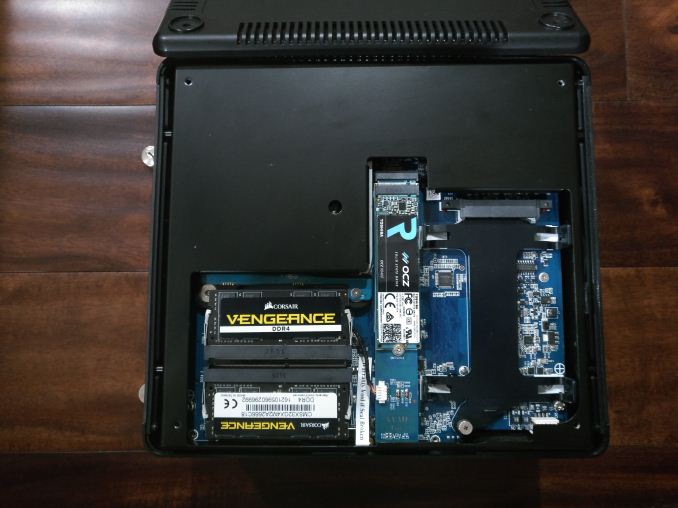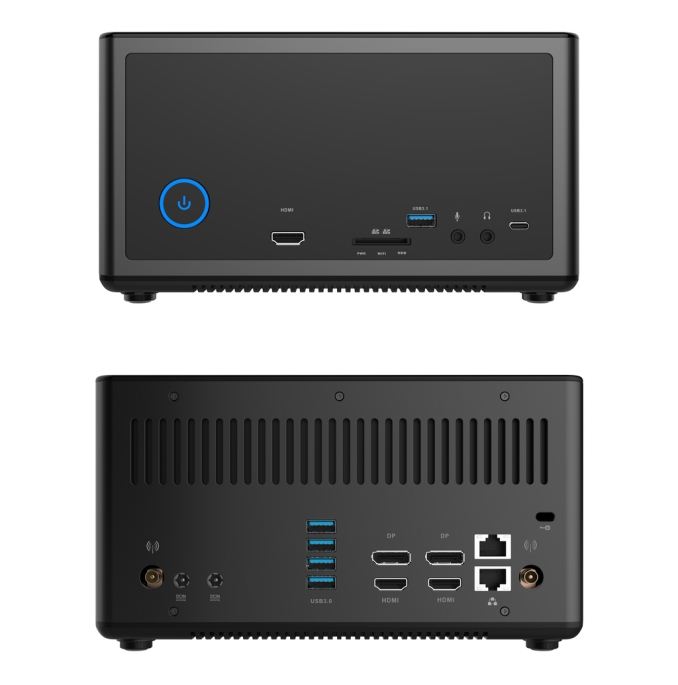Zotac ZBOX MAGNUS EN1080K Compact Gaming PC Review
by Ganesh T S on January 2, 2018 8:00 AM ESTConcluding Remarks
The preceding pages have clearly shown that the Zotac ZBOX MAGNUS EN1080K delivers great performance despite its compact footprint. With the Core i7-7700, it can perform as well as any custom-built desktop rig with a 65W TDP CPU. On the GPU side, it can only be bettered by systems with SLI GPUs. Performance wise,the EN1080K should be able to tick all the boxes. The barebones pricing is also slightly lower than the launch price of the EN1080. However, the RAM and flash prices have gone up in the meanwhile, making our EN1080 and EN1080K builds almost the same in price. In any case, it is clear that Zotac is competing against desktop PCs from boutique PC vendors at this price point, and we have to say they are doing quite an effective job.
Note the raised M.2 slot (compared to the EN1080's M.2 slot) that allows the SSD to make contact with the underside of the chassis and dissipate heat via conduction
We previously talked briefly about how the 3rd generation system addresses some shortcomings of the previous flagship MAGNUS units, and it warrants repeating - the thermal solution for M.2 SSDs has improved significantly. Kaby Lake is also able to deliver idle power benefits, while boosting the possible peak performance. In effect, the EN1080K deserves all the praise that the EN1080 received, and more.
Though Zotac has addressed the M.2 thermals issue, some of our other feedback points from the EN1080 review still stand. A PCIe bridge for the SDXC slot instead of the USB 2.0 bridge (this can improve speeds with the latest UHS-II cards capable of operating at more than 150 MBps), and a 2x2 Wi-Fi radio (in fact, we are ready to sacrifice one of the two LAN ports for a 2x2 radio) would increase the appeal of the unit. It would also be nice to have a couple more USB 3.0 Type-A ports on the sides of the chassis, or, in the front panel. It would not be a bad idea to convert a couple of the USB 3.0 ports in the rear to USB 2.0 (as they probably get used for the keyboard and/or the mouse), while shifting the USB 3.0 ports to a more accessible place. We would also like Zotac to explore internal PSUs without incurring a significant penalty in the chassis size. The usage of two power bricks might not be amenable to all usage scenarios.
Unfortunately, there have also been some changes in the PC ecosystem since the introduction of the EN1080. In order to be worthy of flagship status, systems need to incorporate more features, and support emerging use-cases. The list of features that we would like Zotac to tackle in upcoming iterations are listed below:
- Addition of SGX support to the BIOS
- Replacement of the ASM1142 USB 3.1 Gen 2 daughterboard with integrated Thunderbolt 3
- Enabling usage of the Intel iGPU in the BIOS
- Addition of a display output from the Intel iGPU with HDMI 2.0 / HDCP 2.2 capabilities.
SGX is needed to support features of some softwares such as CyberLink PowerDVD 17. This is also related to the enabling of the Intel iGPU as well as the addition of a HDMI 2.0 / HDCP 2.2 port from it - these are necessary for PowerDVD 17 to be able to play back Ultra HD Blu-ray titles, when an optical Blu-ray drive is attached to the system.
On the whole, the Zotac ZBOX MAGNUS EN1080K is a powerful product with features and performance not available in any other PC of its size. Similar to the EN1080, its pricing is competitive when compared against corresponding offerings from boutique PC vendors.












12 Comments
View All Comments
Sane Indian - Tuesday, January 2, 2018 - link
Why Mini PCs cost more than a Laptop or proper desktops?https://www.acer.com/ac/en/US/content/predator-mod...
TheinsanegamerN - Tuesday, January 2, 2018 - link
Because it is even MORE tech, more power hungry, with more cooling then any laptop, in a smaller space, with a smaller market?DanNeely - Tuesday, January 2, 2018 - link
Even lower production volumes than laptops, meaning each sale has to cover a larger chunk of the total R&D budget.nerd1 - Tuesday, January 2, 2018 - link
It does NOT cost more than equivalent laptop (7700 and GTX 1080)Rookierookie - Tuesday, January 2, 2018 - link
On Newegg, a Clevo laptop with i7-8700K, GTX 1080, 32GB RAM, 512GB SSD+1TB HDD goes for $2449. So pretty darn close.JoeyJoJo123 - Tuesday, January 2, 2018 - link
"free" keyboard, mouse, display included with the Clevo, as well. And the thinner profile more easily fits into a backpack or carrying bag, as opposed to a cube-like shape.cosmotic - Wednesday, January 3, 2018 - link
At least the zotac doesn't look like a tragedy like the Clevo.Death666Angel - Wednesday, January 3, 2018 - link
The Zotac EN1080K goes for 1910€ in Germany. Cheapest 1080 laptop is and ASUS ROG with a 6700HQ, 512GB SSD and 16GB RAM. 6-core 8700 based Schenker Laptop (Clevo rebrand) goes for 2820€. The Zotac with 512GB SSD and 16GB RAM is 2200€, plus OS, so maybe 2250. But for that I would bet you get better cooling and much better IO options. Sure, you lose the built in display and peripherals, but they serve different use cases. If you want a luggable, portable solution, why look at this thing. If you want a stationary thing that is out of the way, why look for a laptop with a large footprint.Flunk - Wednesday, January 3, 2018 - link
It's mostly because the Clevo is enormous. You pay for the engineering to get something this small.Flunk - Wednesday, January 3, 2018 - link
This is also a bit of boutique system, they're not going to sell many of these.